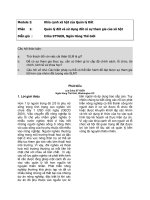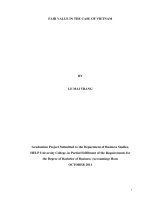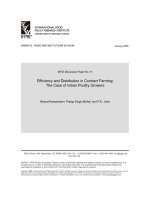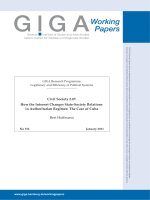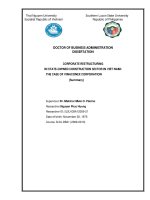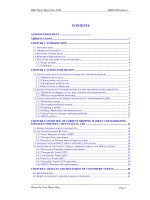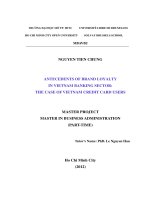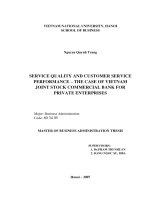Liquidity premium in stock returns, the case of vietnam
Bạn đang xem bản rút gọn của tài liệu. Xem và tải ngay bản đầy đủ của tài liệu tại đây (1.2 MB, 75 trang )
UNIVERSITY OF ECONOMICS
INSTITUTE OF SOCIAL STUDIES
HO CHI MINH CITY
THE HAGUE
VIETNAM
THE NETHERLANDS
VIETNAM – NETHERLANDS PROGRAM FOR MA IN
DEVELOPMENT ECONOMICS
LIQUIDITY PREMIUM IN STOCK RETURNS,
THE CASE OF VIETNAM
A thesis submitted in partial fulfilment of the requirement for the degree of
MASTER OF ART IN DEVELOPMENT ECONOMICS
By
TRẦN QUANG DUY
Academic supervision
Dr. PHẠM PHÚ QUỐC
HO CHI MINH CITY, December 2015
DECLARATION
It is to certify that this thesis entitled “Liquidity premium in stock returns, the case of
Vietnam” meet all requirements for the Master Degree of Art in Development Economics. This
thesis and all contents presented in it are developed by me as my own original research. It is neither
in part nor in whole been presented for another degree elsewhere.
Trần Quang Duy
…………………………….
………………………………
(Author’s name)
(Signature)
(Date)
LIQUIDITY PREMIUM IN STOCK RETURNS, THE CASE OF VIETNAM
Page | i
ACKNOWLEDGEMENT
Firstly, I would like to express my profound appreciation to my supervisor, Dr. Phạm Phú
Quốc. He has kindly guided and shared with me his experience as well as knowledge about
conducting a research. He always reminded me and assist me in selecting the right path for my
thesis.
I also would like to say thank to Dr. Võ Hồng Đức, who initially shared with me the idea
about research in stock returns
My special thanks to Nguyễn Duy Tân and Võ Thế Anh, who dedicated their time and
effort in helping me attain the huge data set for this thesis as well as overcame number of obstacles
during my thesis.
I would like to express my sincere gratitude toward all lectures and staffs in Vietnam
Netherlands program for their kindness and dedication in teaching and providing the best study
environment.
Furthermore, I would like to say thank to all my friends in the course of my study at this
program. We have studied and been through many subjects, assignments together. They always
beside and remind me whenever I feel discouragement so that I can finally finish this thesis.
Last but not least, I am indebted to my parents who gave me all the love and support for
every steps of my life. Their contribution is enormous and I can never pay back this.
LIQUIDITY PREMIUM IN STOCK RETURNS, THE CASE OF VIETNAM
Page | ii
ABSTRACT
Research about the role of liquidity in explaining stock returns has mainly been conducted
in developed market and yielded ambiguous conclusion about its explanatory power. From this
gap in literature, this empirical research is conducted to examine the influence of liquidity on stock
returns in Vietnam stock market, a frontier market. From literature of liquidity and stock returns,
there are number of available proxies for liquidity. In this research, Turnover and Amihud
illiquidity ratio are selected as two main liquidity proxies. These two proxies were selected because
they showed a great consistency and reliability among available liquidity proxies for empirical
research. This study also includes some common explanatory variables in stock return literature as
control variables in empirical regressions. These variables are five premium factors of Fama and
French as well as cumulative returns factor. All of these factors are constructed by using portfolio
formation method of Fama and French. The sample for this research includes all non- financial
firms in Ho Chi Minh stock exchange (HOSE) for period 2007 to 2013. The regression method is
Fama MacBeth which is often employed in finding stock returns. This research reveals some
noticeable findings. Firstly, liquidity negatively related to stock returns. This finding was reliable
as two liquidity proxies point to the same conclusion. Secondly, all Fama and French factors
showed that they are very effective in explain stock returns as all these variables present very
convincing results. Thirdly, the empirical result from this study fail to support the role cumulative
return factor in explaining stock returns in Vietnam.
Key words:
Fama and French factors, turnover measure, Amihud illiquidity ratio, stock returns,
Fama McBeth regression, listed companies, SMB, HML, CMA, RMW.
LIQUIDITY PREMIUM IN STOCK RETURNS, THE CASE OF VIETNAM
Page | iii
TABLE OF CONTENTS
CHAPTER 1:
INTRODUCTION ............................................................................................. 1
1.1
PROBLEM STATEMENT: ............................................................................................. 1
1.2
RESEARCH OBJECTIVE: ............................................................................................. 4
1.3
RESEARCH QUESTION: ............................................................................................... 4
1.4
RESEARCH SCOPE: ...................................................................................................... 4
1.5
RESEARCH METHODOLOGY: .................................................................................... 4
1.6
THE STRUCTURE OF THIS THESIS: .......................................................................... 5
CHAPTER 2:
2.1
LITERATURE REVIEW .................................................................................. 7
FUNDAMENTAL THEORIES: ...................................................................................... 7
2.1.1
The Efficient Market Hypothesis: ............................................................................. 7
2.1.2
Modern Portfolio Theory: ......................................................................................... 8
2.1.3
The Capital Asset Pricing Model: ........................................................................... 11
2.2
ASSET RETURNS LITERATURE:.............................................................................. 13
2.2.1
Theoretical vs Data Mining Research: .................................................................... 13
2.2.2
Fama – French Three Factors Model: ..................................................................... 14
2.2.3
Carhart Four Factors Model: ................................................................................... 17
2.2.4
Fama – French Five Factors Model: ....................................................................... 18
2.3
LIQUIDITY LITERATURE: ......................................................................................... 21
2.3.1
Transaction Cost Theory: ........................................................................................ 22
2.3.2
Subsequent Development in Liquidity research: .................................................... 24
2.4
MAIN HYPOTHESIS: ................................................................................................... 27
CHAPTER 3:
3.1
DATA AND METHODOLOGY .................................................................. 29
REGRESSION MODEL AND RESEARCH FRAMEWORK: .................................... 29
3.1.1
Regression Models: ................................................................................................. 29
3.1.2
Research Framework: ............................................................................................. 31
3.2
DATA ............................................................................................................................. 31
3.3
REGRESSION METHOD: ............................................................................................ 31
3.4
VARIABLES ................................................................................................................. 32
3.4.1
Dependent Variables: .............................................................................................. 32
3.4.2
Explanatory Variables:............................................................................................ 32
LIQUIDITY PREMIUM IN STOCK RETURNS, THE CASE OF VIETNAM
Page | iv
3.4.3
3.5
Control Variables: ................................................................................................... 37
DATA PROCESSING: .................................................................................................. 38
3.5.1
Primary Data Calculation:....................................................................................... 38
3.5.2
Factor Construction:................................................................................................ 40
3.6
SOLVING POTENTIAL ECONOMETRIC ISSUES: .................................................. 46
3.6.1
Dealing with Heteroscedasticity and Autocorrelation: ........................................... 46
3.6.2
Dealing with Multicollinearity: ............................................................................... 47
CHAPTER 4:
4.1
DATA ANALYSIS AND RESULTS ........................................................... 53
DESCRIPTIVE STATISTIC: ........................................................................................ 53
4.1.1
Turnover Measure: .................................................................................................. 53
4.1.2
Amihud Illiquidity Ratio: ........................................................................................ 54
4.2
ECONOMETRIC RESULTS: ....................................................................................... 55
4.2.1
Empirical Results for Turnover Measure:............................................................... 55
4.2.2
Empirical Results for Amihud’s Illiquidity Measure: ............................................ 57
4.3
DISCUSSIONS: ............................................................................................................. 58
CHAPTER 5:
CONCLUSION ............................................................................................... 61
5.1
OVERVIEW: ................................................................................................................. 61
5.2
EMPIRICAL RESULTS: ............................................................................................... 61
5.3
CONTRIBUTIONS:....................................................................................................... 62
5.4
IMPLICATIONS:........................................................................................................... 62
5.5 LIMITATIONS AND FUTURE RESEARCH SUGGESTION: ........................................ 63
REFERENCE ................................................................................................................................ 64
APPENDIX ................................................................................................................................... 67
APPENDIX 1: TWO STAGE FAMA MACBETH REGRESSION ....................................... 67
LIQUIDITY PREMIUM IN STOCK RETURNS, THE CASE OF VIETNAM
Page | v
LIST OF ABBREVIATIONS
HOSE
: Ho Chi Minh City Stock Exchange
NYSE
: New York Stock Exchange
EMH
: Efficient Market Hypothesis
MPT
: Modern Portfolio Theory
CAPM
: Capital Asset Pricing Model
SMB
: Small minus Big
HML
: High minus Low
CMA
: Conservative minus Aggressive
RMW
: Robust minus Weak
FF
: Fama and French
LIQUIDITY PREMIUM IN STOCK RETURNS, THE CASE OF VIETNAM
Page | vi
CHAPTER 1:
1.1
INTRODUCTION
PROBLEM STATEMENT:
This problem statement will firstly discuss about the essential role of stock market in each
country as the stock market provides multiple benefits for investors, corporations and country‘s
economy. Drawing from these benefits, the second paragraph will mention about the establishment
of stock market in most countries around the world. With the establishment of stock market and
involvement of many social parties, stock returns become a special interest for many participants,
especially for participants who directly engaged in the market. From this realistic need of many
social parties about stock returns, the third, fourth and fifth paragraphs are dedicated for discussion
about the quest of researchers in studying determinants of stock returns and the emergence of
liquidity as one determinant of stock returns. The rest of this problem statement will demonstrate
that current trend of liquidity research was excessively concentrated on developed market and there
is an obvious need to have a thorough research about the influence of liquidity on stock returns in
a frontier market, such as Vietnam.
Stock market is undeniably an integral part of each country economy. Stock market provide
number of benefits for individual investors, corporations and economy. For corporation, stock
market allow company to gain access to huge capital market. Once the company is listed, it can
expand its capital through share issuance. In addition, merge and acquisition can be facilitated by
share purchase in the stock market. For investors, stock market provide investors a channel for
investing their money. There are many different types of companies which should suit the taste of
different investors. About economy, the key benefit of stock market is that it promotes economic
growth by encouraging investors to put their saving into listed companies. As a result, it
encourages the companies’ development and promotes economic growth.
With all of these advantages, stock market has been developed in many countries.
Developed countries have their stock markets established for over centuries ago. With the
establishment of stock market and involvement of many social parties, the stock returns become a
special interest for many participants, especially for participants who directly involved in the
market. Specifically, for investors, stock returns is a major factor in deciding where their fund will
be invested. For corporations, stock return should be a reliable gauge of companies’ performance
as investors purchase and sell companies’ stock based on its fundamental and prospect. For
economy and government, stock return is a dependable barometer for gauging the economic
LIQUIDITY PREMIUM IN STOCK RETURNS, THE CASE OF VIETNAM
Page | 1
condition of a country. The stock price reflects the macroeconomic condition and major changes
in country economy. The rise and fall of stock price often coincides with economic cycle of a
country (Pujari, 2010). As a result, government can observes the health of their stock market and
promulgates suitable policies to regulate and develop their own economy.
From this realistic need, many researchers have been devoting their efforts in studying
about determinants of stock returns and its mechanism. The literature on stock returns nowadays
is incredibly enormous and many scholars still keep searching for unknown determinants and new
methodologies.
In reality, one factor that attracted attention of stock market participants and it has been
noticed for a long time, this is liquidity. Liquidity is commonly defined as the ability to purchase
or sell a large quantity of stocks quickly at low cost without affecting the price significantly (Choe
& Yang, 2008). Through many years, investors observed that liquid stock can be easily converted
into cash without much difficulties. In contrast, illiquid stock caused some level of difficulties for
investors when they want to convert the stocks into cash. It often requires investors to sell at a
lower price or endure a greater transaction cost for the sale. With this in mind, investors well aware
of the liquidity premium (the price spread between liquid and illiquid stocks). However, there
wasn’t any remarkable study about liquidity until the well-known paper of Amihud and Mendelson
(1986).
Amihud and Mendelson (1986) were the pioneers in liquidity research when they proposed
the transaction cost theory. In their landmark paper, they found out evidence that there is a
significant liquidity premium in asset return. Since the publication of this paper, many scholars
started to develop this new field of literature. Many new proxies for liquidity have been formulated
due to the need for measuring liquidity in different stock market. After years of liquidity research,
some scholars agreed on the view that investors often require a higher rate of stock returns in
compensating for illiquidity (Amihud, 2002), (Brennan & Subrahmanyam, 1996), (Brennan,
Chordia, & Subrahmanyam, 1998), (Chordia, Roll, & Subrahmanyam, 2000). This basically means
liquidity affects negatively on stock returns. Nonetheless, there is divergence from the above
viewpoint when other researchers found an opposite relationship. They claimed that the
relationship is actually positive. To support this viewpoint, they also had their arguments and
empirical researches (Bali, Peng, Shen, & Tang, 2014), (Abzari, Fathi, & Kabiripour, 2013).
An important fact is that the majority of researches about liquidity has been conducted in
developed financial market, especially in United States (where most of data are available and it is
LIQUIDITY PREMIUM IN STOCK RETURNS, THE CASE OF VIETNAM
Page | 2
one of the most developed financial market in the world). However, Bekaert, Harvey, and
Lundblad (2007) stated that the liquidity effect should be stronger in emerging market than in
developed one. They stated some rationales for their conclusion. The first reason is that poor
liquidity was the main factor that prevented foreign institutional investors from invest their money
into different types of stock in emerging market. As a result, this would intensify the liquidity
premium (frontier market even suffers a greater liquidity gap than emerging market). Secondly,
many emerging market went through market liberalization during their research period. And this
incident should assist researchers in study the importance of liquidity on expected return. The
reason is that, after liberalization, the liquidity often increases noticeably in comparison with prior
liberalization period. Thirdly, developed markets often have diversified ownership structure with
both long term and short term investors. Thus, Bekaert et al. (2007) suggest the clientele effects in
selecting investment portfolio should reduce the pricing of liquidity. In case of emerging markets,
the diversification in number of securities and ownership is lacked of which often intensify the
liquidity effects.
From above discussion, there is an obvious need for conducting a research about liquidity
premium in frontier market, which is considered as a pre-emerging market. The first reasons is
that there is a divergence in viewpoint among researchers about the influence of liquidity on stock
returns. In addition, the liquidity gap between liquid and illiquid stocks in frontier market, such as
Vietnam, is very significant. Last but not least, the number of researches about liquidity in frontier
market, especially in Vietnam, are very limited. This cannot provide a thorough understanding
about the role of liquidity in Vietnam stock market. The only paper that I found, which studied the
relationship between liquidity and stock returns in Vietnam, is from Xuân Vinh and Hồng Thu
(2013). This paper, however, published a positive relationship between liquidity measures and
stock returns (a negative relationship between illiquidity measures and stock returns). They
provide two rationales for their findings. The first rationale is that investors in Vietnam are small
and trade frequently. They believed this will boost the demand for large and liquid stocks and will
create a higher return on these stocks. The second rationale is that Vietnamese stock market is a
newborn market and there are many newly listed stocks every year. These new stocks will create
a huge uptrend in price and volume at their Initial Public Offer which cause an increase in both
liquidity and stock price.
I believed their rationale is quite vague and their method for constructing the liquidity
measures is different from the well – known method of Fama and French (2013).
LIQUIDITY PREMIUM IN STOCK RETURNS, THE CASE OF VIETNAM
Page | 3
All above reasons have motivated me to conduct a thorough research about liquidity
premium in Vietnam financial market using a well-known method from Fama and French (2013).
This research hopefully will provide an additional piece in literature about liquidity premium in
Vietnam stock market, a frontier market.
1.2
RESEARCH OBJECTIVE:
The specific objectives of this study are:
To empirically examine the influence of liquidity on stock return in Vietnam (a frontier
market) by using renowned Fama and MacBeth (1973) method.
1.3
RESEARCH QUESTION:
Does liquidity influence on stock returns?
1.4
RESEARCH SCOPE:
This thesis will focus on study the effect of liquidity on stock returns of listed companies
in Ho Chi Minh Stock Exchange (HOSE) from January 2008 to December 2013.
The reason for choosing HOSE as the primary stock exchange for this study is because of
following rationales: (1) HOSE require a more stringent process for audited financial information
and public exposure than Ha Noi Stock Exchange (HNX), (2) HOSE comprises of bigger market
cap and more prestigious companies than HNX, (3) the total market capitalization of HOSE is
significantly larger than HNX (as of 16 April 2015, the market capitalization of HOSE is 1.051.445
billion VND, while HNX market capitalization is 139.980 billion VND), and (4) the market
liquidity of HOSE is also remarkably greater than HNX (as of 16 April 2015, the daily traded
amount in HOSE is 1.825 billion VND, while HNX’s daily traded amount is 729 billion VND).
With all of these reasons, selecting HOSE as primary trading exchange for collecting data should
ensure the quality and prevent possible biases for this research.
1.5
RESEARCH METHODOLOGY:
This thesis will be conducted by using Fama and MacBeth (1973) regression method. This
method allow us to resolve issues in panel data, especially designed for dealing with financial data.
In addition, all factors and portfolios in this thesis are constructed by using premium method of
Fama and French (1993). This method is well-accepted as a standard in building explanatory
factors for explaining stock returns. This will help improve the validity in final conclusion of this
thesis.
LIQUIDITY PREMIUM IN STOCK RETURNS, THE CASE OF VIETNAM
Page | 4
The basic procedure for constructing premium factor includes three main phases for each
variable. All variables are derived from this procedure, except for SIZE, HML, RMW and CMA
variables where their daily values are not available. The first phase is primary data calculation in
which required daily data for each variable is collected from Vietstock and financial audited
statement. The daily data for each variable will contain all non-financial firms traded in HOSE in
a specific year. These individual firm data is then calculated based on a distinct formula of each
variable to derive individual firm value for each variable. These daily firm value of each variable
is then averaged out to obtain the average daily value of each firm during a year.
In the second phase, all yearly average firm value of each variable will used to calculated
breakpoint for premium portfolios. These portfolios are constructed on annual basis in order to
update about fundamental change in each variable for each year. The breakpoints are decided in
corresponding to each variable which are often selected at 30 and 70 percentile of yearly average
value of all firms. Subsequently, each firm is allocated into one appropriate portfolio
corresponding to its own yearly average value.
In the third phase, after each firm is allocated into one distinct portfolio based on its
individual variable value, average monthly stock return of all firms within a portfolio is combined
to calculate the average monthly return of a whole portfolio. The premium factor is finally derived
by subtracting the average monthly return of first and the last portfolio within each variable. The
underlying idea for this whole lengthy procedure is to compute the excess stock return by simply
employing a passive investment strategy with each premium factor. For example, with Size factor,
the size premium is the excess stock return an investor can earn by simply buying stock of small
companies and selling their current stock of large companies.
1.6
THE STRUCTURE OF THIS THESIS:
This thesis contains six chapters with the following arrangement:
Chapter 1 provides an overview of thesis with problem statements for selecting this subject,
research question, research scope, basic information about data and methodology. Chapter 2
focuses literature review. In this chapter, some fundamental theories in finance is first reviewed.
Then, related literature about dependent and independent variables will also be explained. Notably,
the theoretical and empirical studies about liquidity is carefully presented in a separate section of
chapter 2. The final section of this chapter will be dedicated for the main hypothesis and its
rationales.
LIQUIDITY PREMIUM IN STOCK RETURNS, THE CASE OF VIETNAM
Page | 5
Chapter 3 concentrates on data and methodology. Firstly, two regression models and
research framework will be discussed to provide an overview to readers. Following this section,
data and regression method section will be presented. After that, variables section will concisely
introduce about dependent and independent variables in this thesis. The subsequent section in
chapter 3 will concentrate on data processing and construction of each variables. The last section
of this chapter will be dedicated to potential econometric issues and how they can be solved in this
thesis.
Chapter 4 will focus on statistical and empirical result of this study. At the end of the
chapter, some discussions about the final result are also put forward which show noticeable
observations as well as comments about this research. Chapter 5 will be devoted for the conclusion,
possible implications and some drawbacks of this thesis. It also suggests a direction for further
research about stock returns in frontier market, especially in Vietnam.
LIQUIDITY PREMIUM IN STOCK RETURNS, THE CASE OF VIETNAM
Page | 6
CHAPTER 2:
LITERATURE REVIEW
The capital market theories laid the foundation for the subsequent formation of financial
asset pricing models. The current and prominent view of finance scholars support the view of
perfectly efficient capital market in which financial asset prices is quickly and accurately adjust to
new information as it is available to the market. In a perfect efficient capital markets, investors are
considered to be risk – averse and rational in their decision making.
Under the assumption of perfect efficient capital market, Efficient Market Hypothesis
(EMH) was developed and published by Fama (1970) which is considered as a fundamental theory
of modern finance. However, the efficient market hypothesis didn’t give investors any guidance
in assigning their assets. As a result, other theories are introduced to assist risk – averse investors
in allocating their assets in an efficient capital market. The most renowned theory among them are
Modern Portfolio Theory (MPT) (Markowitz, 1952).
Within the stream of market portfolio framework, risk – averse investors are believed to
have homogenous expectations about the covariance, variance and mean of the asset returns, and
they always strive to obtain maximum expected utility in their investment decisions. In essence,
MPT theory suggests a method to diversify and achieve optimal risk portfolio for investment. The
only source of risk to the portfolio is derived from its co-movement corresponding with the market
portfolio. Capital Asset Pricing Model (CAPM) is subsequently developed as an extension of the
MPT theory, this theory provides investors with a tool to price assets in an efficient market.
This literature will first review some fundamental theories of contemporary finance which
are efficient market hypothesis, efficient capital market, and capital asset pricing theory. These
theories form the foundation for the current research in asset returns. After reviewing these
theories, the literature and empirical research of related variables in this study will be discussed.
Base on the literature and empirical review of all variables, main hypothesis for this study will be
constructed.
2.1
FUNDAMENTAL THEORIES:
2.1.1 The Efficient Market Hypothesis:
The concept of efficient market is used to define a market where investors cannot
consistently outperform other investors by making abnormal return after adjusting for risk. Fama
(1970) defined perfect efficient capital market as: “a market in which firm can make production
investment decisions and investors can choose among the securities that represents ownership of
LIQUIDITY PREMIUM IN STOCK RETURNS, THE CASE OF VIETNAM
Page | 7
firms’ activities under the assumption that the security prices at any time fully reflect all available
information”.
In trading activities, investors employ all trading information that available to them as tools
in order to make profits in the market. There are numbers of information which available to
investors. The most basic instruments are the historical price patterns, traded volume data. Other
information is company related public announcement. Besides, there is an existence of inside
information which usually did not completely comprehended or accessible to all investors.
Fama (1970) reviewed the work of previous researchers about asset prices in capital market
and put forward his theory about different form of efficient capital market based on the types of
information and how these information are incorporated into asset prices. Fama (1965) asserted
that there are three basic level of market efficiencies: strong form, semi – strong form and weak
form. Each type of market efficiency provide an increase level of market efficiency which excludes
certain group of investors to continuously outperform the market by using specific type of
mentioned information as their trading tools. With an increasing level of market efficiency,
specific types of information that investors utilize to outperform the market will become less
effective because other investors would also study the use of these information and act
correspondingly to it. In weak form efficient market, all historical price patterns are fully
incorporated into asset prices. Therefore, technical analysts who employ price and volume data
cannot generate a positive abnormal return on a regular basis in this form of market. A semi –
strong form level, EMH hypothesis asserted that asset prices incorporated all current and publicly
available information into it, hence, fundamental analysts who utilize economic and company
performance information cannot outperform the market in this form of efficient market. In the
strong form efficient market, the inside information do not only accessible to company insiders
but to outsiders. Hence, investors, who use inside information for making investment decision, do
not outperform the market of this form.
2.1.2 Modern Portfolio Theory:
On the ground of the efficient market hypothesis and principle of diversification,
Markowitz (1952) developed a first theory of portfolio management using the concept of risk. All
investors are assumed to be risk – averse base on the expected utility theory (a conventional
expected utility curve is plotted in Figure 1 below).
LIQUIDITY PREMIUM IN STOCK RETURNS, THE CASE OF VIETNAM
Page | 8
Figure 1: Marginal Utility and Risk Aversion
Figure 1 presents that the wealth is positive related to its utility as a greater wealth or asset
position provide a higher utility to investors. However, the curve also exhibits diminishing
property which indicates the marginal utility derived from the increase in asset position will rise
at a slower pace than the increase in asset position. The interpretation is that investors will not
accept for risky investment without adequate compensation for its risk.
The investment decision based on the utility function above is rational and do not expose
to any psychological biases as the decision is solely depend on the calculation different possible
combination of asset portfolio in Equation 1:
E (U) = p1 u(x1) + p2 u(x2) +……+ pn u(xn)
With
(1)
x1, x2,… xn are the possible asset position in a combination
P1, p2, …, pn are the probabilities associated with each asset position.
Employing the concept of risk aversion into portfolio selection process, rational investors
would prefer to select investment that offer higher expected level of return for the same level of
risk or lower risk for the same level of expected return into their portfolio. The expected value and
risk for a portfolio is calculated in a manner of Equation 2 and 3 below which is a mathematical
equation for mean and variance of 2 two assets:
E (Rp) = wi E(Ri) + wj E(Rj)
(2)
P 2 = wi2 i2 + wj2 j2 + 2 wi wj I j ij
(3)
With wi and wj are the weight of each component in the portfolio.
i and j are the standard deviation of each component in the portfolio.
ij is the correlation between for every two components in the portfolio.
LIQUIDITY PREMIUM IN STOCK RETURNS, THE CASE OF VIETNAM
Page | 9
From the above equation, portfolio return is calculated as weighted average of the return
of its components, whereas the risk of the portfolio is computed from the standard deviation of
historical return of each component which is less than weighted average of the standard deviation
of its components. It is due to the return of each component in the portfolio is rarely perfectly
correlated, therefore, the specific risk of the portfolio is successfully diversified. As Equation 3
shown, the lower the correlation efficient between each pair of component in the portfolio, the
lower is the standard deviation and variance of the portfolio. Therefore, the portfolio risk does not
rise as the same ratio as the increase in expected return of portfolio when new assets is combined
into the portfolio.
Incorporating the discussed theory, Markowitz (1952) derived the efficient frontier of risky
asset from optimization of mean variance (the objective is to maximize the expected return at every
level of variance from possible combination of assets). The asset combination laid on the efficient
frontier represents the efficient mean – variance combination of assets, which means the
combination provide highest expected return for a specific level of risk and is preferred by risk –
averse investors.
Figure 2: Markowitz Efficient Frontier
LIQUIDITY PREMIUM IN STOCK RETURNS, THE CASE OF VIETNAM
Page | 10
However, the Markowitz efficient frontier only comprises of risky assets. In order to
manage the risk more effective, investors can allocate a fraction of their capital into assets that
provide certainty return (risk free assets). Common risk free assets are Treasury bill and bond with
virtually zero probability of default.
Consider the efficient mean – variance portfolio A and B in Figure 2, all the combination
between risk free asset and portfolio A can be depicted by Capital Allocation Line for A (CALA)
which is connected from Risk Free point to A on the Efficient Frontier Curve. Similarly, the Capital
Allocation Line for B (CALB) is created in the same manner. CALA outperforms CALB since any
combination between portfolio A and risk free assets provide a higher expected return than any
combination between portfolio B and risk free assets given the same level of risk. Therefore, CALA
would be preferred by risk averse investors than CALB. Using the same approach and keep moving
upward along the Efficient Frontier, the optimum Capital Allocation Line can be reached by
tangent line between CAL of M and Efficient Frontier Curve. This optimum CAL is called the
Capital Market Line (CML) which delivers the highest expected return for a given level of risk
and lowest risk for any given level of expected return.
Equation 4 shows the mathematical calculation of Capital Market Line that expected return
on an Efficient Frontier Portfolio is equal the return on risk free asset (Rf) plus the Market Risk
Premium (E(RM) – Rf) time the ratio between total risk of the portfolio and total risk of Market
Portfolio.
(4)
With E (RP)
expected return of Portfolio P;
E (RM)
expected return of Portfolio M;
Rf
return of risk free asset;
P
the variance of portfolio P;
M
the variance of portfolio M;
2.1.3 The Capital Asset Pricing Model:
Market Portfolio Theory provide risk averse investors a foundation for understanding about
asset allocation in an Efficient Market. However, these theory did not provide a mechanism for
pricing assets or portfolio in an efficient market. Therefore, Capital Asset Pricing Model (CAPM),
LIQUIDITY PREMIUM IN STOCK RETURNS, THE CASE OF VIETNAM
Page | 11
as an extension of MPT, provides risk averse investors a single factor linear model for computing
the equilibrium rate of assets return in an efficient market. The model is developed by three
researchers: Sharpe (1964), Lintner (1965), Mossin (1966), each researcher contribute
independently to CAPM model.
The basic assumption of CAPM is that unsystematic risk (firm specific risk) can be
diversified away, therefore, the only systematic risk (market risk) is required to endure by
investors. Furthermore, the systematic risk for a given asset can be measured by its covariance
with market portfolio (i,M).
Substituting (i,M) into Equation 4, a relationship between risk and expected return can be
derived as Equation 5 below:
(5)
By defining βi (Beta of asset i) = i,M / M 2, Equation 5 can be rewritten as:
(6)
Equation 6 is termed the Security Market Line (SML) equation. Equation 6 basically said
that, in equilibrium condition, the expected return on portfolio i (E(Ri)) is equal to return of Risk
free asset (Rf) plus the market risk premium (E(RM) – Rf) in proportion to its systematic risk (βi).
As a result, it can be interpreted that assets with higher βi (higher systematic risk) must provide a
higher return to investors for enduring a higher risk investment. A systematic risk – expected
return relationship of SML is described in Figure 3:
Figure 3: Security Market Line (SML)
LIQUIDITY PREMIUM IN STOCK RETURNS, THE CASE OF VIETNAM
Page | 12
When the market is in equilibrium, an efficient portfolio should be graphed on SML line
which delivers a return appropriate to their systematic risk. An undervalued asset is drawn above
the SML line as it delivers a higher return than expected from the market in corresponding to its
systematic risk. On contrary, an overvalued asset is sketched below the SML line as it delivers a
lower return than expected in corresponding to its systematic risk.
Although the CAPM model was built on a solid foundation with its fundamental economic
theory, there are number of drawbacks from CAPM model. Firstly, Roll (1977) critiqued that
market in CAPM theory does not only consist on Equity Market, where most of Empirical Test on
CAPM is carried out, but a Portfolio of all wealth. A market Portfolio, according to Roll (1977),
should comprises bonds, stocks, properties, human capital and any other assets that contribute to
the wealth of mankind. From this view point, he further asserted that the CAPM can only be tested
when the true market portfolio is known with certainty. And tests of CAPM is only a test of mean
– variance efficiency of the Portfolio that is considered as market proxy. Due to this reason, a
finding of a mean – variance efficiency Portfolio within any sample cannot inform researchers
whether CAPM model is correct or not.
Moreover, apart from its weakness, there are increasing evidences that Beta is not the only
risk factor affecting stock returns. There are many other factors which can be named, such as book
to market ratio (Fama & French, 1992), company size (Banz, 1981), price / earnings ratio (Basu,
1977) and a number of other systematic factors. These factors will be discussed in details in
following sections.
2.2
ASSET RETURNS LITERATURE:
2.2.1 Theoretical vs Data Mining Research:
After recognized the possible flaws of CAPM, many researchers had embarked on finding
additional factors which can explain the assets return. Generally, these models act as a refinement
in spirit of CAPM by adding other explanatory factors to capture more the movement of asset
prices. The influential factors on stock return, but not Beta factor of CAPM, are now
conventionally called anomalous variables or anomalies. Although, some of the models have been
proven to add more explanatory power to observed asset return, for example Fama and French
(1993) Three factor models and Carhart (1997) model, these models were considered a result of
fitting data stream rather than establish from theoretical foundation. Black (1998) considered the
famous Three Factors Model of Fama and French (1993) as “data mining” because conducting a
research with sizable of potential explanatories variables should produce some positive result.
LIQUIDITY PREMIUM IN STOCK RETURNS, THE CASE OF VIETNAM
Page | 13
Furthermore, Subrahmanyam (2010) expressed that: “the tendency of scholars to use one
methodology or the others raise the question of whether the results are robust to different
methodology”.
As a result, a question that many people might concern is why academic in Finance were
so committed to “data mining”. There are some convincing explanations for this question. Firstly,
Dempsey (2013) revealed that: “a good deal of finance is now an econometric exercise in mining
data either for confirmation of a particular factor model or for the confirmation of deviation from
the model’s prediction as anomalies”. From the argument of Dempsey (2013), the persistent use
of “data mining” originated from the desire to support the scholar’s prior belief.
Secondly, the Economist magazine (20 -26 November 2010) gave us another persuasive
reason for high level data mining that stem from the establishment of CRSP data base. It is
estimated that more than one – third of published researches have been conducted by using data
from CRSP data base. The data base has given financial scholars an enormous opportunity to
perform their econometric and “data mining” research.
2.2.2 Fama – French Three Factors Model:
From above literature, we would accepted explanatory factors are not always derived from
theoretical background, but it might be derived from different researches on a particular data base
or “data mining” activities. Therefore, it is hard to claim what Asset Pricing Model is the best
model. A more suitable question would be to ask what Model and Explanatory Variables should
be the most appropriate for a particular research. Three renowned Asset Pricing Model will be
discussed below which were constructed during a search by many scholars to explore other
significant explanatory factors for asset return.
Two famous researchers in Finance, Eugene Fama and Ken French have performed
extensive researches about Asset Pricing. In 1993, they came up with a conclusion that apart from
the market risk premium (Beta), “value” factor and “size” factors can explain a significant portion
of asset returns. In order to account for these factors, SMB is constructed to represent “size” factor
and HML is constructed to address “value” factor.
SMB variable is an abbreviation of Small Minus Big and designed to capture the excess
return which investors can earn by investing their money into a relative small capitalization
company instead of putting their money into a big market capitalization company. Similarly, HML
variable is an abbreviation of High Minus Low and designed to capture the excess return which
investors can attain by investing their money into high book to market ratio (B/M) companies
LIQUIDITY PREMIUM IN STOCK RETURNS, THE CASE OF VIETNAM
Page | 14
instead of putting their money into low B/M ratio companies (Book to Market ratio is a ratio where
company value calculated by accountants is divided by company value in stock exchange market).
Although these factors were not built upon a strong theoretical foundation, these factors do
provide a meaningful interpretation about their significance. Firstly, for SMB factor, the intuitive
behind is that small companies should be more vulnerable to many risk factors due to their relative
small size and undiversified nature. Thus, a substantial reduction in their ability to confront
negative economic and financial events. Therefore, investors require a higher return as a premium
for taking extra risk in this investment. Secondly, for HML factor, the intuitive behind this factor
is that a company with high B/M ratio is an indication that the value of the company in public
market has decreased due to company current situation or low expected future earnings. As a result,
we expect that these companies should be more vulnerable to various risks and have lower returns
in comparison to those with low B/M ratio (which means they are valued higher by the public
market). So that, investors also require a higher return as a premium for taking extra risk in buying
high B/M ratio stocks.
In summary, the formation of Fama – French Three factor model is as below:
Rit – RFt = ai + bi(RMt – RFt) + siSMBt + hiHMLt + eit
(7)
bi is a coefficient of relationship between asset return and market risk premium.
sA is a coefficient of relationship between asset return and size factor
hA is a coefficient of relationship between asset return and value factor.
The Model can be considered as an expansion of CAPM model since it combines the
traditional market risk factor with two new factors. This model explained the return of assets in
correspondence with three risk factors: market risk premium, size risk and value risk.
2.2.2.1 Empirical researches of Three Factors Model:
The effectiveness of Fama and French Three factors model has been tested by many
empirical studies in different market. Most of these studies provide positive feedbacks toward the
model.
K. S. Lam (2002) carried out a research on 100 companies over the period 1980 – 1997
and traded on Hong Kong stock exchange. He investigated the relationship between stock returns
and β, size, leverage, book to market equity ratio, earning/ price ratio in Hong Kong follows Fama
and French approach. The result of this research failed the role of β in capturing the average
monthly return of stocks listed in the period July 1984 – June 1997. However, the result was very
supportive for size, book to market ratio and earning/ price ratio since they can explained a large
LIQUIDITY PREMIUM IN STOCK RETURNS, THE CASE OF VIETNAM
Page | 15
portion of cross sectional variation in average monthly return. They also concluded that book
leverage and market factors do have explanatory power over the variation of cross sectional return.
Nevertheless, these factors seem to be redundant when above three factors are included in the
model. The result is also consistent across different size groups and months. So that, the result is
not effected by extreme observations and abnormal return behavior in different size groups or
months.
Ajili (2003) conducted a test between Fama and French three factors and the Characteristic
model of Daniel and Titman (1997) on French stock market in 1976 – 2002 period. Stock are
sorted into different portfolios of size and book/ market ratio following Fama and French
methodology. Some noticeable inferences from this research are that 90.5% on average of the
expected return is explained by the power of 6 size and B/M ratio portfolios. Moreover, the
prediction, that the intercepts in the regression of characteristic balanced portfolio of FF Three
factors model should be zero, is support by the study over the Characteristic model of Daniel and
Titman (1997) which predicted that these intercepts should be negative.
In a study by Drew (2003), he conducted a test between CAPM model and FF Three factor
model for Hong Kong, Korea, Malaysia and Philippine during the 1990 – 1999 period. He found
that CAPM model alone were not capable of explaining cross sectional of stock returns in these
countries and the absolute pricing errors of the CAPM is larger in comparison with FF Three
factors model. Overall, the research concluded that size and book to market ratio factors did play
a significant role in capturing the movement of cross sectional stock returns
O'Brien, Brailsford, and Gaunt (2008) provide a thorough study about value premium in
Australian stock market when they conducted a test covered 98% of Australian listed firm over a
period of 25 years. Before their research, “size effect” is recognized in Australia but the lack of
data have limited the ability of researchers to analyze the “value effect” in Australian market.
Brailsford, Gaunt, and O'Brien (2012) also emphasized that: “for the first time in Australia, with
both time series and cross sectional test, the constructed factors reveal a significantly positive
priced premium”. The authors also suggested that Fama Three factors model had a better
explanatory power than CAPM in explaining asset returns when it explained nearly 70% of the
movement in return.
LIQUIDITY PREMIUM IN STOCK RETURNS, THE CASE OF VIETNAM
Page | 16
2.2.3 Carhart Four Factors Model:
The four factors model was put forward by Carhart (1997) as a result from momentum
effect presented by Jegadeesh and Titman (1993). The momentum effect could not be explained
by the famous Three Factor Model of Fama and French.
In a study by Jegadeesh and Titman (1993), portfolios were created by using an assumption
that the stocks has made gain (or loss) in the past will continue to make gain (or loss) in the future.
The time frame for momentum effect fluctuate from 3 – 12 months. The four factor model was
then tested by Carhart in 1997. This model was created by adding Momentum factor of Jegadeesh
and Titman (1993) to the Three factors Model of Fama – French. The formation of Model is as
below:
(8)
The only factor which was added is PR1YR (represent Momentum) calculated by taking
the difference between highest 30% return of prior 12 months and lowest 30% return of prior 12
months. The test was carried out by Carhart and successfully confirmed the validity of Momentum
factor in explaining stock returns.
2.2.3.1 Empirical researches of Carhart Four Factors Model:
Four factors model of Carhart was tested in many countries and also yielded positive results
toward the model. L’Her, Masmoudi, and Suret (2004) conducted a Four factor model test on
Canadian stock market over 1960 – 2001 period. FF methodology is used to construct the risk
factors. The result showed that, in Canadian market, the “size” factor is remarkably higher in
January in comparison with other months. In addition, the “momentum” factor is always
meaningful during a year, with the only exception of January. Book to market ratio returns has a
highly significant value in down trend market. Whereas, in the uptrend, the book to market factor
just barely have explanatory power on the stock return. Macro environment also considered in this
research, particularly the monetary policy environment. In the expansive monetary policy
environment, the “size” and “value” premium were founded to be highly significant.
Bennaceur and Chaibi (2007) performed a test on Tunisian stock exchange with different
model from CAPM to FF Three factor model and Carhart 4 factors model in order to test
explanatory power of these asset pricing models. The performance of each model is evaluated by
using Schwartz and Akaike indicators. The result from the model suggested that the momentum
premium is the highest premium (8.8%) in Tunisian Stock Exchange (TSE). The value premium
LIQUIDITY PREMIUM IN STOCK RETURNS, THE CASE OF VIETNAM
Page | 17
is 2.88% and relatively smaller than other premium. Surprisingly, the size premium in this paper
has a negative value (- 3.4%) which disagrees with other literatures where the small firm
commonly deliver higher return. Overall, the paper claimed that the best Asset Pricing Model for
Tunisian Stock Market is the Carhart four factor model when all the selecting criteria guided to
the same conclusion.
K. S. Lam, Li, and So (2010) provided another study supporting the 4 factors model. The
study was conducted in Hong Kong stock market during 1981 – 2001 period. After testing the four
factors model with data from Hong Kong stock market, all four factors were founded to have
significant explanatory power. Moreover, the intercept also was unveiled to be insignificant
different from zero. A further supportive evidence for the Carhart four factor model when value of
adjusted R2 is relatively high and the residual standard deviation of additional explanatory
variables is insignificant which mean a large portion in stock returns variation had been
successfully explained by Carhart model.
2.2.4 Fama – French Five Factors Model:
Many researchers, who completed their empirical researches in different market, claimed
that Fama French Three Factors Model (TFM) indeed provide explanatory power of average stock
returns. However, the explanatory power of the TFM is still weak since a portion of average returns
left unexplained. As a result, Fama and French persistently put their effort in developing a better
asset pricing model. During their research, profitability and investment factors arose as new
explanatory factors with supporting theoretical framework from dividend discount model.
Additionally, there are number of empirical studies which have been conducted and gave positive
result of these two factors.
Initially, the Dividend Discount Model claimed that the market value of a stock is a sum
of discounted value stream of expected dividends for each share.
Mt =
E (d
1
t
) / (1 r )
(9)
Mt denoted share price at time t
r is the long term expected stock return or internal rate of return of expected dividends
E(dt+) is the expected dividend per share for time (t+).
From equation (9), we can infer that if two different stocks which offer investors the same
expected dividends but their share prices are different, the lower price’s stock would be required
LIQUIDITY PREMIUM IN STOCK RETURNS, THE CASE OF VIETNAM
Page | 18
